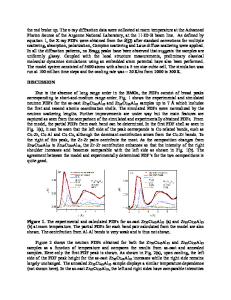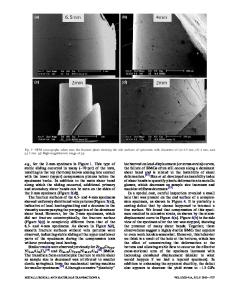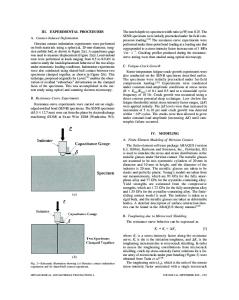Effects of partial crystallization on compression and fatigue behavior of Zr-based bulk metallic glasses
- PDF / 334,606 Bytes
- 8 Pages / 585 x 783 pts Page_size
- 23 Downloads / 328 Views
Y. Yokoyama Advanced Research Center of Metallic Glasses, Institute for Materials Research, Tohoku University, Sendai 980-8577, Japan
M. Freels and R.A. Buchanan Department of Materials Science and Engineering, The University of Tennessee, Knoxville, Tennessee 37996
A. Inoue Advanced Research Center of Metallic Glasses, Institute for Materials Research, Tohoku University, Sendai 980-8577, Japan
C.R. Brooks Department of Materials Science and Engineering, The University of Tennessee, Knoxville, Tennessee 37996 (Received 15 June 2006; accepted 25 October 2006)
Zr50Cu40Al10, Zr50Cu30Al10Ni10, and Zr50Cu37Al10Pd3 (in at.%) are bulk metallic glasses (BMGs) with partial crystallization that were characterized by x-ray diffraction (XRD). The study of mechanical properties was conducted in compression at room temperature. Four-point-bend fatigue experiments were performed on the zirconium (Zr)-based BMGs in air. Under compressive loading, after the elastic deformation, no obvious plasticity occurred before the final shear fracture. The compression strengths are comparable to those of fully amorphous alloys. However, the fatigue-endurance limits of these BMGs were much lower than those of fully amorphous alloys. These results suggested that the fatigue behavior of a BMG is very sensitive to the microstructure, while the compression strength is not.
I. INTRODUCTION
After the rapid development in the last decades, the cooling rate required for forming metallic glass has lowered significantly from 105–106 K/s to 1 K/s. Correspondingly, the dimension of the metallic glass improved from thin layers to several centimeters.1–4 The low critical cooling rates make it possible to prepare bulk metallic glasses (BMGs) by a conventional copper-mold-casting technique.1–4 In addition, the large size of samples motivates researchers to study all kinds of physical and chemical properties of BMGs. The research reveals that BMGs have many excellent mechanical properties: high strengths (even ultrahigh strengths of over 5 GPa); high hardness; high fracture toughness; and high elastic strain limits.1–6 These properties of BMGs suggest their use in
a)
Address all correspondence to this author. e-mail: [email protected] DOI: 10.1557/JMR.2007.0059 J. Mater. Res., Vol. 22, No. 2, Feb 2007
http://journals.cambridge.org
Downloaded: 17 Mar 2015
structural engineering applications. For example, golf clubs fabricated of zirconium (Zr)-based BMGs, Vitreloy 1, have been developed and marketed.1,2,7 In fact, the above research results on BMGs have opened a window to create a new generation of structural materials for applications in such fields as aircraft frames, rotating equipment, automobiles, and medical implants.2 Although the mechanical behavior of BMGs is being studied widely,8–14 little attention has been paid to their fatigue properties. Moreover, the fatigue behavior is poorly understood. Gilbert et al.15 and Hess et al.16 performed four-point-bend fatigue experiments on a Vitreloy 1 beam specimen and obtained fatigue-endurance limits, bas
Data Loading...











